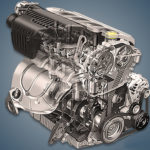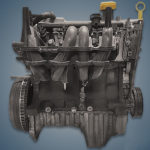The 1.3-liter turbo engine Renault H5Ht or 1.3 TCe 150 has been produced in Spain since 2017 and is installed on models such as the Arkana, Captur and Duster, as well as on Nissan as the HR13DDT. This motor was developed jointly with the Daimler concern and on its models is known as the M282.
The TCe line includes engines: H4Bt, H4Dt, H5Dt, D4Ft, H5Ft, H5Ht, H4Jt, M5Mt, M5Pt, F4Rt.
At the very end of 2017, a new 1.3-liter turbo engine jointly developed by Renault-Nissan and Daimler debuted, known as the H5Ht, HR13DDT, and M282, respectively. Here, an aluminum block with plasma-sprayed steel on the cylinder walls instead of liners, an aluminum 16-valve cylinder head with hydraulic compensators, inlet and outlet phase shifters, a direct injection system, a timing chain drive and a Garrett NGT1241MKSZ turbine with an intercooler.
Also of the interesting features, we note a variable displacement oil pump, an exhaust manifold integrated into the head of the block, piston cooling oil nozzles.
Specifications
| Production years | since 2017 |
| Displacement, cc | 1332 |
| Fuel system | direct injection |
| Power output, hp | 115 – 163 |
| Torque output, Nm | 220 – 270 |
| Cylinder block | aluminum R4 |
| Block head | aluminum 16v |
| Cylinder bore, mm | 72.2 |
| Piston stroke, mm | 81.4 |
| Compression ratio | 10.5 |
| Features | no |
| Hydraulic lifters | yes |
| Timing drive | chain |
| Phase regulator | yes |
| Turbocharging | yes |
| Recommended engine oil | 0W-40, 5W-40 |
| Engine oil capacity, liter | 6.0 |
| Fuel type | petrol |
| Euro standards | EURO 5/6 |
| Fuel consumption, L/100 km (for Renault Arkana 2020) — city — highway — combined |
9.1 6.0 7.1 |
| Engine lifespan, km | ~300 000 |
| Weight, kg | 105 |
The engine was installed on:
- Renault Arkana 1 (LCM) since 2019;
- Renault Captur 1 (J87) in 2018 – 2019; Captur 2 (JB) since 2019;
- Renault Clio 5 (BF) since 2019;
- Renault Duster 2 (HM) since 2019;
- Renault Kadjar 1 (HA) since 2018;
- Renault Kaptur 1 (H5) since 2020;
- Renault Koleos 2 (HC) since 2020;
- Renault Megane 4 (XFB) since 2018;
- Renault Scenic 4 (JFA) in 2017 – 2022;
- Renault Talisman 1 (L2M) since 2019.
Disadvantages of the Renault H5Ht engine
- The only massive problem with this turbo engine is floating speed. Like all direct injection combustion engines, this one suffers from carbon deposits on the intake valves. However, if the problem is not running, then they are cleaned with special tools quite easily.
- Most owners of cars with this engine do not complain about oil consumption, but there are such cases and they are not so few. You need to understand that here is an aluminum block with an open cooling jacket, which leads with mileage and the piston gap grows.
- And on the network you can find complaints about the loss of traction due to the fault of a flown turbine pipe, the rapid wear of spark plugs and ignition coils, as well as the failure of the adsorber valve.







How about anti freeze level constantly going down and oil level going above max? They are probably connected.
Also, there were (not few but rather many) engines that needed to be resealed due to oil leaks in the first 30-50k miles.